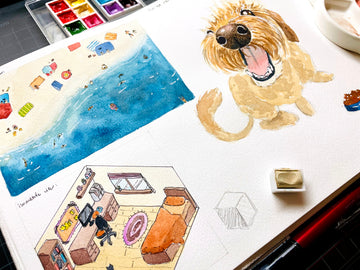When artists talk about perspective, they’re usually referring to one-, two-, or three-point perspective (which we’ve already covered in this blog post). However, I’d like to introduce you to a few more perspectives, this time in the sense of differing points of view rather than number of vanishing points.
Bird’s-Eye View

The first you’ve probably seen and heard of before – the bird’s-eye view. This is simply viewing as if you were a bird flying in the sky, so looking from top down to the earth below.
Since many people don’t own a helicopter or a plane, the best way to find a good reference is either to head up a skyscraper (if you live in or near a large city), doing an image search, or checking out Google Maps. You can sometimes spot some interesting views this way, taking note of the area’s infrastructure and geographical layout.
For example, the reference I used to paint the image above was based on a picture of a bird’s-eye view of a beach.
A bird’s eye perspective is quite simple in the sense that it’s almost like looking at a 2D image, though if you factor in the curvature of the earth, then it might get a little more complicated. But for a pure bird’s-eye perspective, it should feel like drawing simple 2D shapes.
Fisheye View

The next perspective is also quite common, as photographers sometimes use a special wide-angle lens to fit more within the frame, even though it creates a “bulging” effect. Nowadays, wide-angle lenses can more or less adjust themselves to get rid of this curving effect, but some people still like this effect.
It creates a sense of curiosity and wonder, as it feels like you’re looking up close at something. To create this effect, you can curve your perspective lines so that they form contours around a spherical (or elliptical) shape.

To make it easier, you can draw a circle, then draw contour lines in the horizontal and vertical direction so that it curves around to create the illusion of a sphere. Then, whatever you draw within should follow those curves – vertical lines with the vertical curves, and horizontal lines with the horizontal curves.
It will take a bit of practice to be able to get the right feeling, and if it ever gets too difficult, you can look up photographs that have been taken using a fisheye view, and follow the way the image curves.
Tip: It’s possible to vary the amount of warping going on, so you can make things curve more or less depending on your perspective lines.
Isometric View

The last view I want to touch on is the isometric view. This is commonly used in engineering and for technical illustrations, though it’s been popping up more frequently in both the art world (e.g. M.C. Escher’s work) and in the gaming world.
So-called because its perspective lines fall on isometric planes, it gives equal weight to each side, resulting in a very clean and organised aesthetic.
The effect is best described with a cube, which has equal sides. An isometric drawing of one will have it perfectly angled so that each visible face is identical to each other.
If you look at paper made with isometric gridlines, you’ll see that they’re made up of equilateral triangles, so that while the vertical axis remains the same, the horizontal one angles 60º to the left or right of the vertical.
Bonus tip: Some prefer a flatter 30º angle to the 60º one, but the main point is that the angles must be the same on both sides.
This means that it’s the best perspective to work with if you want to present your subject in a clear way, which is why there are a lot of isometric drawings of rooms floating around! All the straight lines and box shapes also make them an easy subject to turn into an isometric drawing, as all they have to do is follow the 60º angle guideline.
Tip: Objects that are irregularly shaped like a blanket or a person can be drawn as they are, though they will need to be in the right plane and perspective. You’ll also be looking at it from a top-down angle, however slight it may be.
More to Explore
I’ve only briefly touched on the more well-known perspectives, but there are more out there that play around with angles and the perception of reality. Of course, it helps to know the basics of perspective, but after that, it’s always fun to play around with a new point of view!
In any case, it won’t hurt to give these a try. Here’s to a lifetime of learning, and to new art discoveries, whether personal or global.
What kind of perspective are you most interested in? Have you tried or heard of any of these before? Let us know in the comments below!
Also, for more tips and techniques about art, feel free to subscribe to our email newsletter! We’ll also keep you updated with our flash sales, product releases, and our workshop schedule.


